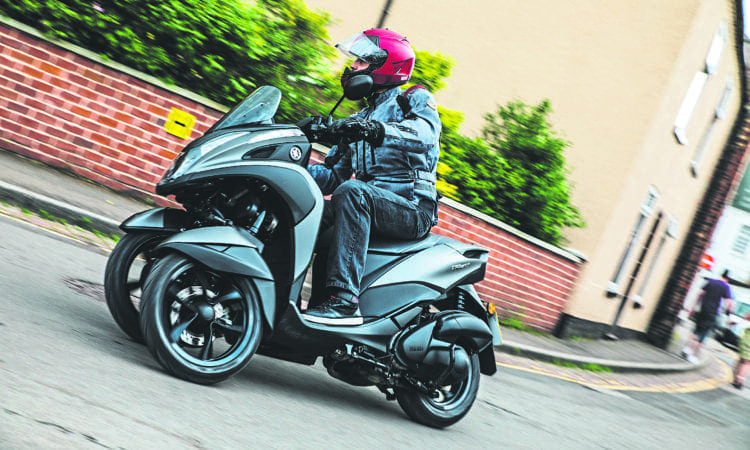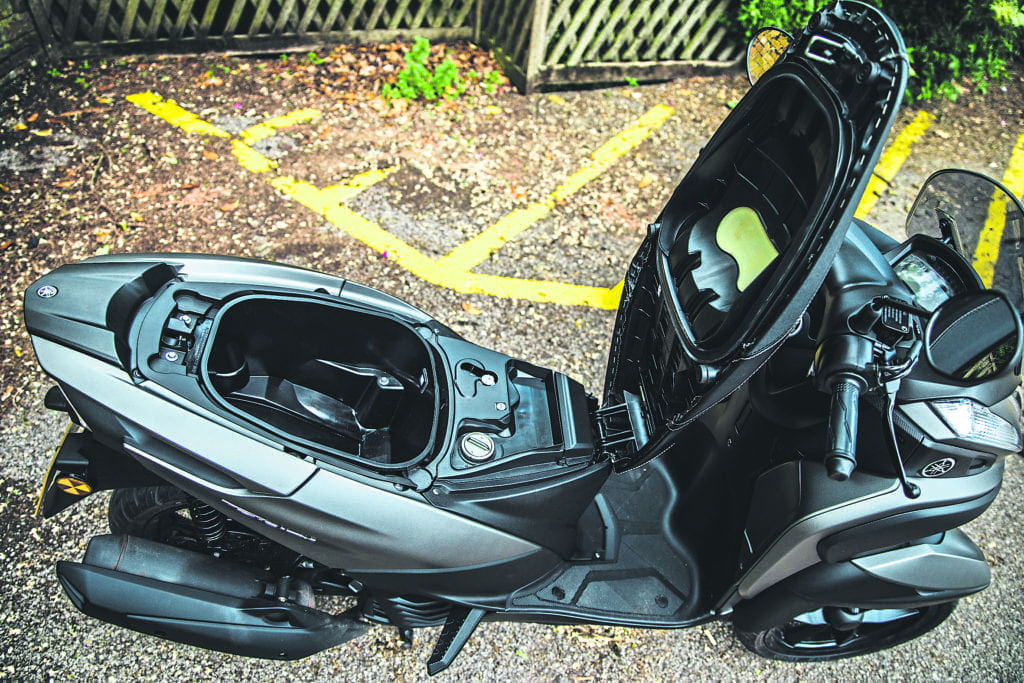A thoroughly practical three-wheeled scooter.
It’s been said that ‘two’s company, three’s a crowd’, but under no circumstances did I feel crowded by the extra wheel that Yamaha have weaved their magic on.
Enjoy everything More Bikes by reading monthly newspaper, Read FREE Online.
My first look at the Tricity made me interested if a little bit sceptical; I felt inquisitive nevertheless. This was to be a step onto (or should I say into) a machine-type I’ve not ridden before. Three wheels on this wagon and I cannot see myself rolling on. My first impression was that it looked kind of like a praying mantis from the front, poised to strike-out with its front wheels. Even from the side its front still has that mantis look, but the back was standard scooter. This isn’t going to feel right is it? That front end’s going to be heavy and cumbersome. No filtering anymore, too wide, no freedom to zip and zoom. That extra weight is going to make it sluggish and loathsome to ride in town, even worse on the open road. Oh hang on, has Yamaha reached an agreement with a tyre manufacturer to shift irregular, rarely used sized tyres, they have stockpiled?
Dispersing the worries
No, that’s all about as wrong as could be. I had misconceptions, worries, even full-blown doubts, but this bike has a strong backbone and has been developed with practical usage in mind. From the outset the Tricity has had full-blown development at its core. And it’s certainly not just a weekend idea bolted together due to an extra order of wheels being delivered, or some mad scientist in a lab coat looking at the mathematics on a blackboard and making two become three while trying to look like Carol Vorderman.
The team that built the Tricity was headed-up by project leader Kazuhisa Takano who’s been in the development department for race machines like the YZR500 and the YZR-M1 that Valentino Rossi raced! He’s quoted as saying: “I actually have a sort of personal obsession with linked mechanisms and suspension structures and did a lot of research on this; not only by computer simulation, but also by making mock-ups with chopsticks or paper models! In the end we found a variation that moved and functioned very well. This was a parallelogram link mechanism, combined with telescopic suspension which gives a very natural feeling to the ride and is an extremely refined piece of technology in the field of motorcycles.”
What’s apparent initially is the weight (or lack of it). That feeling of an over-engineered, heavy, clumsy, lump just isn’t there. This scooter doesn’t come with the standing lock (the ability to lock the front wheels upright) that’s fitted to many three wheel scooters out there and which helps with the ability to ride them on a car licence. As for the sometimes unclear regulation and licence laws for three wheelers; after a check, a double check and a chat with the office elder (Mau) we concur that the Trinity falls into the category of needing an A1 motorcycle licence to ride. You cannot jump onto this scooter if you only have a car licence or have just passed your CBT.
It did take a few mornings to get used to the feeling of the extra wheel when pushing the Tricity in and out of my garage, but that soon passed and you get used to the feel really quickly. The illusion of weight at the front end is more than dispelled once on the road. The clever tech’s at Yamaha have hit the 50:50 weight distribution button square on and within the first couple of miles its abilities are unfurled before you.
It’s not as nippy as some scooters in the 125cc bracket, but the engine provides more than enough power to keep up with urban traffic. The feel is not what you’d initially expect. You may think (as I did) that this would be a heavy, cumbersome unit to wrestle around. You could even think that it would feel wayward (possibly disconnected and numb). This is not the case at all; riding along the road it feels so close to that of a normal 125cc scooter that you soon drop into a normal riding style in no time whatsoever. Initially I did still have some misconceptions, but the Tricity washed them away rapidly. Its front end (due to the well-placed centre of gravity and twin tyres which are slightly narrower than standard) is light, but not washy.
The suspension and chassis are particularly well balanced with no undue feelings of being disconnected from what’s happening under those two front tyres, which do give a larger surface contact area; not too stiff or floaty in feel, but planted and direct. Its balanced braking (tested on a private road away from traffic) is an almost gravity-defying, physics bending experience. That increased surface area of rubber creating friction on the road and obviously the extra front disc pull you up so quick that the first time it almost took me by surprise. The underseat storage is large enough for an open face helmet or a large shopping bag; a small-but-useful front glovebox and a bag hook between your legs adds extra storage capability.
I took the Tricity on a 23-mile trip, then tackled city traffic and roadworks for a few hours to try and find a weak point in its armour. I could bore you witless with my analogies of handling and efficiencies but I couldn’t find one thing I didn’t like. I found myself pushing the Tricity harder and harder into corners and roundabouts and found the level of traction more than surprising. I’m not saying that it’s flawless and did at one point, go a bit too far and lost the front end for a moment. Oops!
You get lots of stares due to that extra front wheel – not a bad thing at all. I ended the day with a 15-mile drive in the dark on narrow B-roads to test how the lights performed. As with nearly all the Yamahas I’ve ridden they didn’t disappoint. The dip is more than powerful enough at what I’d call normal road speed and full beam gives a great spread and throw. The indicators are also really bright and leave other road users with no excuse for not knowing which way you’re telling them you’re going.
The verdict
This is a well-balanced, clever machine, a true step in what could be a new direction. Looking at what the Yamaha engineers have crafted, you’ve no choice but to be enthralled, or even surprised with the outcome. For the commuter this machine offers a real break from the norm; a stable platform and confident-feeling scooter that’s failed to show me any weak points. The front end is marginally wider than on two-wheeled Yamaha scooter, but filtering is no issue and I gained in confidence. And should you be caught in adverse weather you can rely on the extra traction to make your journey hopefully be just that little bit safer.
Advert
Enjoy everything More Bikes by reading the MoreBikes monthly newspaper. Click here to subscribe, or Read FREE Online.





